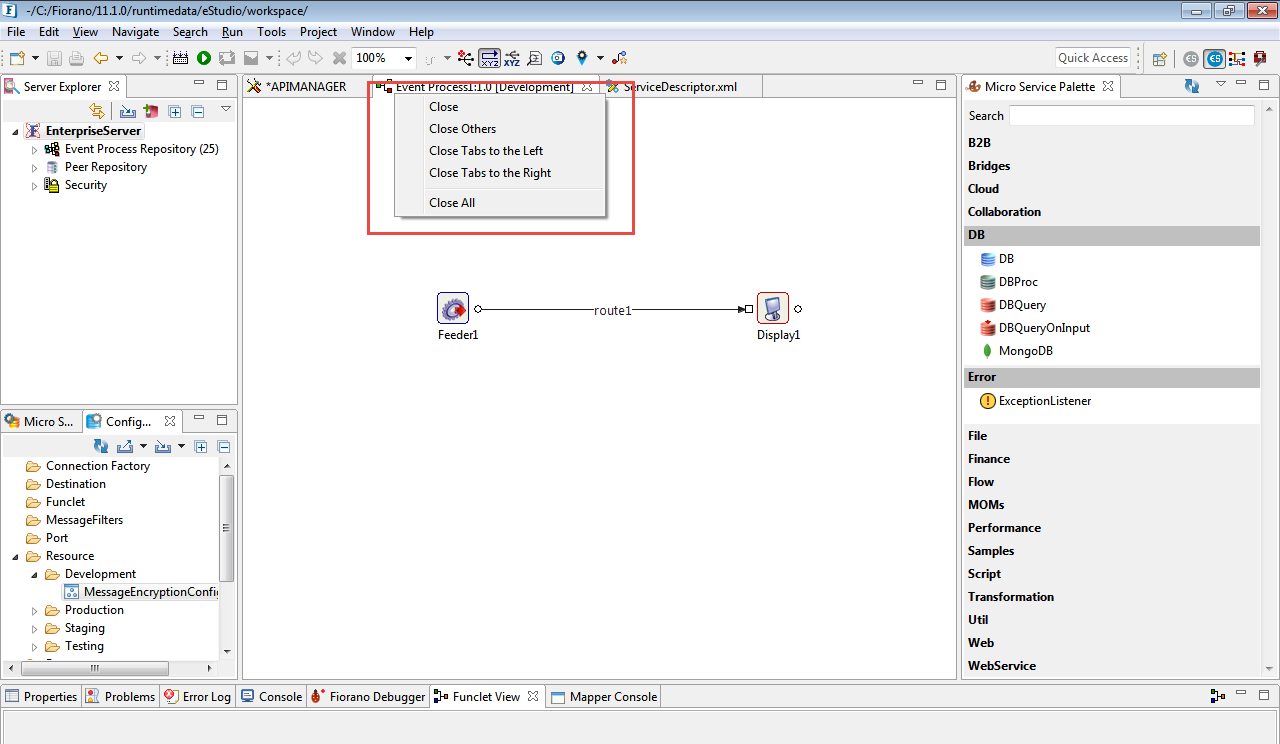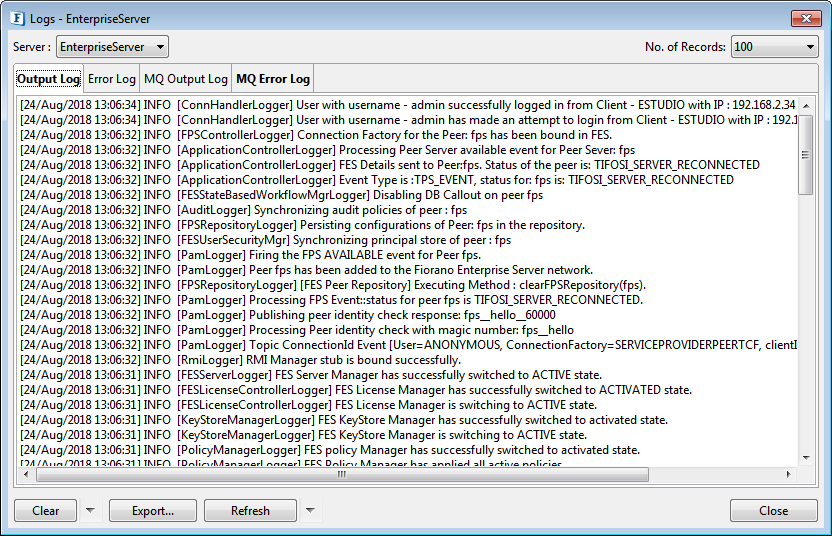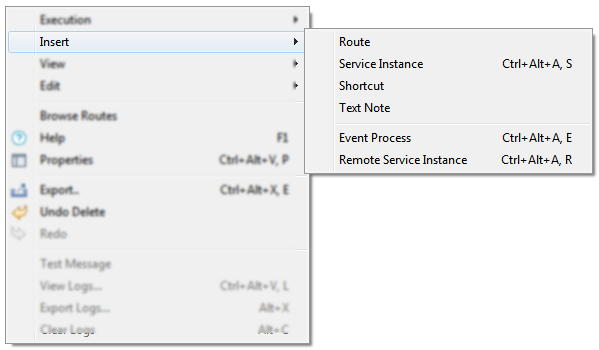Online Event Process Development
Server Explorer
Enterprise Server before logging in
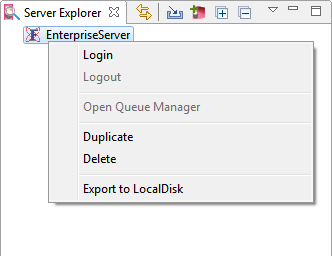
| Option | Description |
| Login | Provide credentials (Default: admin/passwd) to login to the Enterprise Server. |
| Duplicate | To create a copy of the Enterprise Server. |
| Delete | To delete the duplicate of the Enterprise Server or an added server. |
| Export to Local Disk | To save the server with all configuration changes as made. This is performed when the server with a customized configuration has to be used on another instance or a future point of time. |
Enterprise Server after logging in
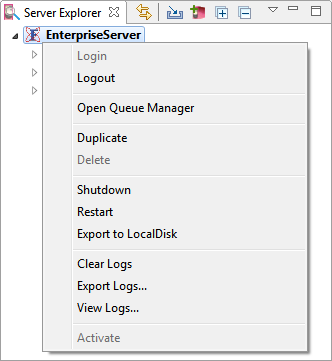
Below descriptions explain the options excluding the ones mentioned in the Enterprise Server before logging in section above.
| Option | Description |
| LogOut | To log out from the logged in Enterprise server. |
| Open Queue Manager | Fiorano Queue Manager tool provides a single view to see all the pending messages in an Event Process. |
| Shutdown | To stop the running server instead of performing it from the command prompt. |
| Restart | It shuts down the running server and restarts. |
| Clear Logs | To delete Output and Error logs pertaining to the Enterprise Server. |
| Export Logs | To save the Enterprise Server logs for future reference or analysis. |
| View Logs | Displays the various message logs in segregated by tabs. |
| Activate | To explicitly activate an inactive server; this option gets enabled in scenarios where multiple servers are running. |
Event Process Repository
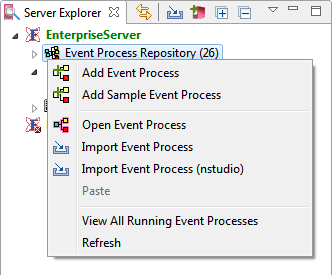
| Option | Description |
| Add Event Process | To add a new event process to the Event Process Repository. |
| Add Sample Event Process | To open a pre-configured sample event process from the ones which are shipped with the Fiorano installation |
| Open Event Process | To open an already saved event process. |
| Import Event Process | To add an Event Process that is saved in a local disk or a server. |
| Import Event Process (nstudio) | To add an Event Process that is exported from nStudio. |
| View All Running Event Processes | To view all the running processes consolidated in a single window. |
Folder in the Event Process Repository
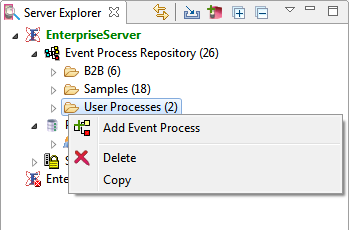
| Option | Description |
| Add Event Process | To add a new event process to the category under Event Process Repository. |
| Delete | The Delete option helps to remove both or one of the below from the particular folder:
|
Event Process
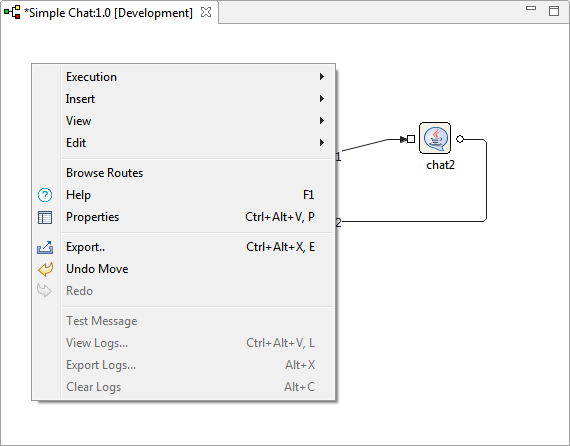
| Option | Description |
| Team |
|
| Validate | |
| Compare With | |
| Check Resources and Connectivity | To do a connectivity and resource check for the Event Process. Refer to the respective section in the Running an Event Process section. |
| Run | To launch the event process after checking resource connectivity. Refer to the Launch Event Process section in the Running an Event Process section. |
| Synchronize | To modify running applications on the fly. Refer to the Synchronizing an Event Process section in the Running an Event Process section. |
| Stop | To stop a running event process. Refer to the Stopping an Event Process section in the Running an Event Process section. |
| Open | To open an event process for editing. |
| Delete | To delete an event process or SBW events in the event process. Refer to the description in the Folder in the Event Process Repository in the Running an Event Process section. |
| Fetch from Server | |
| Refresh | |
| Rename | To rename an event process. |
| Add/View Documents | To add additional information or any particular remarks regarding an event process and attach as a document to the Event Process for future reference purposes. Refer to the Adding Documents to an Event Process section for detailed information. |
| Open Queue Manager | To provide a single view to see all the pending messages in an Event Process. Refer to the Fiorano Queue Manager section. |
| Export | To save the event process as a zip file in the desired location. Refer to the Exporting an Event Process section. |
| Export to File | |
| Save As | To create a copy of an event process. |
| Upgrade Version | To create a different version of an event process. |
| View Logs | To check Output and Error logs of service instances in the event process. |
| Export Logs | To export logs of service instances in the event process. |
| Clear Logs | To remove the event process logs. |
| Show Configuration Usages |
Fiorano Orchestrator
In an Event Process

| Option | Description |
| Execution |
|
| Insert |
|
| View | |
| Edit | |
| Browse Routes | |
| Help | |
| Properties | |
| Export | |
| Undo Delete | |
| Redo | |
| Text Message | |
| View Logs | |
| Export Logs | |
| Clear Logs |
Closing Windows
When multiple windows are opened in eStudio, it may be closed
- Close: Closes the selected event process.
- Close Others: Closes all other event processes other than the selected one.
- Close Tabs to the Left: Closes the windows on the left side of the selected event process.
- Close Tabs to the Right: Closes the windows on the right side of the selected event process.
- Close All: Closes all event processes including the selected one.
